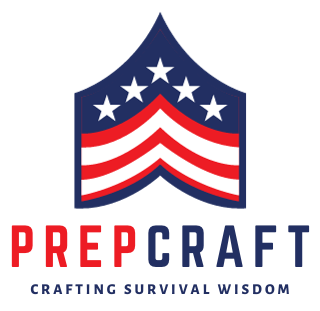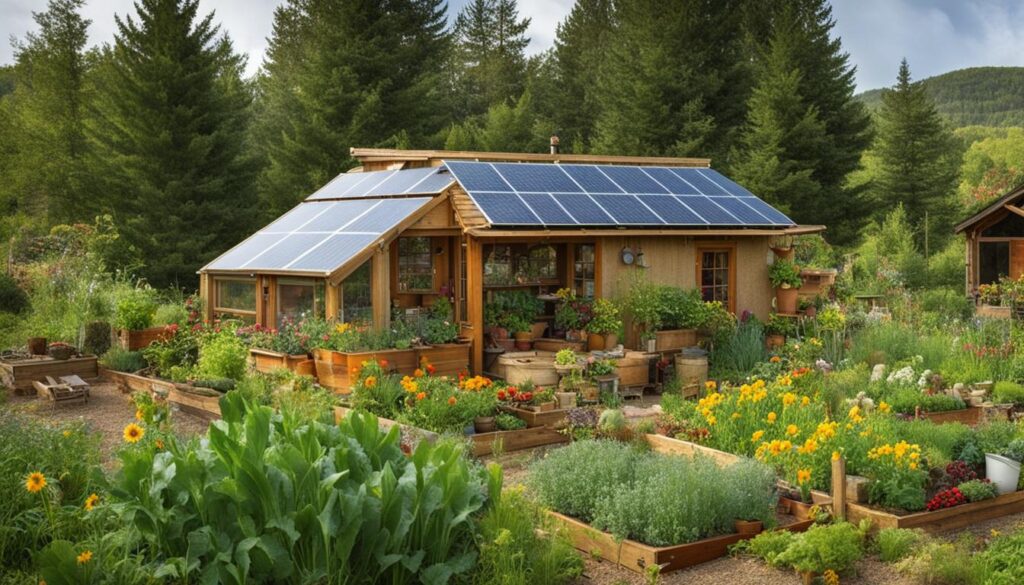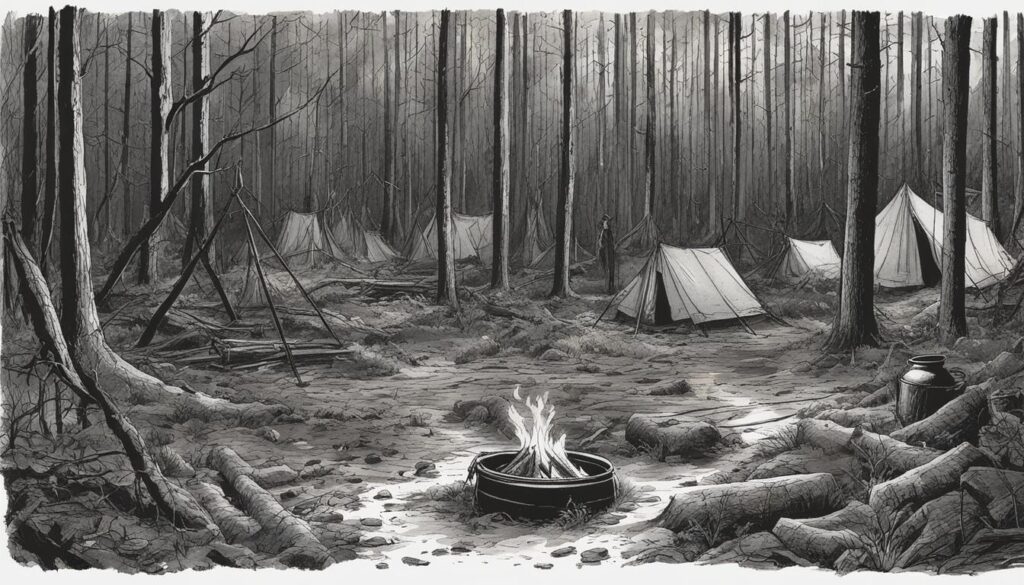
In a long-term survival situation, being able to procure your own food is essential for self-sufficiency and wilderness survival. Hunting and trapping for food can provide you with the high-fat and protein-rich sustenance you need to survive. By learning effective hunting strategies and building a variety of traps, you can greatly increase your chances of successfully finding and capturing game.
When it comes to hunting, it’s important to understand the behaviors of animals and how to track them. By studying field guides on animal tracking and spotting game trails, you can gain valuable insights into the habits and movements of different species. This knowledge will help you identify optimal locations to set traps, such as game trails, watering holes, and feeding sites.
Survival traps are designed to choke, crush, hang, or entangle wild animals. Snares and deadfalls are among the most commonly used types of traps. Snares are small nooses that tighten around an animal’s neck, while deadfalls are designed to crush the animal once the trigger is released. Baiting your traps can significantly improve your chances of a successful catch.
Key Takeaways:
- Survival hunting and trapping are crucial skills for self-sufficiency in the wilderness.
- Understanding animal behaviors and tracking is essential for successful hunting.
- Building a variety of traps, such as snares and deadfalls, increases your chances of capturing game.
- Baiting your traps can greatly improve your trapping success.
- Studying field guides on animal tracking and trapping techniques is highly recommended.
How to Use Survival Traps and Snares
In a survival situation, knowing how to effectively utilize survival traps and snares can greatly increase your chances of catching food. These tools are designed to choke, crush, hang, or entangle wild animals, and they can be constructed using natural materials. Here are some essential tips and techniques for using survival traps and snares:
1. Snares
Snares are small nooses that tighten around an animal’s neck, capturing them safely. To set up a snare, follow these steps:
- Identify known animal trails or outside den holes where animals are likely to pass.
- Choose a thick and sturdy cordage material for the noose, ensuring it is large enough for the animal’s head to pass through.
- Secure the snare to a firmly anchored object, such as a tree or a stake.
- Position the snare at an appropriate height, so the animal’s head will enter the noose when passing through.
Remember to check your snares regularly to increase your chances of success.
2. Deadfalls
Deadfalls are traps designed to crush an animal once the trigger is released. The Figure Four and Paiute Deadfall are two common types:
“The Figure Four deadfall is a simple yet effective trap that requires four wooden sticks. The trap works when the bait is dislodged, causing the horizontal stick to fall and crush the animal. The Paiute Deadfall is constructed using three sticks and a bait platform. When the bait is taken, it triggers the vertical stick to fall, crushing the animal underneath.”
When building deadfalls, be precise in carving screwdriver points and notches on the sticks to ensure they work together properly.
3. Baiting your Traps
Baiting your traps is a crucial step in attracting animals and increasing your chances of success. Consider using food sources that are appealing to the targeted animals, such as fruits, nuts, or pieces of meat. Placing the bait strategically near your traps will entice animals into triggering the trap mechanism.
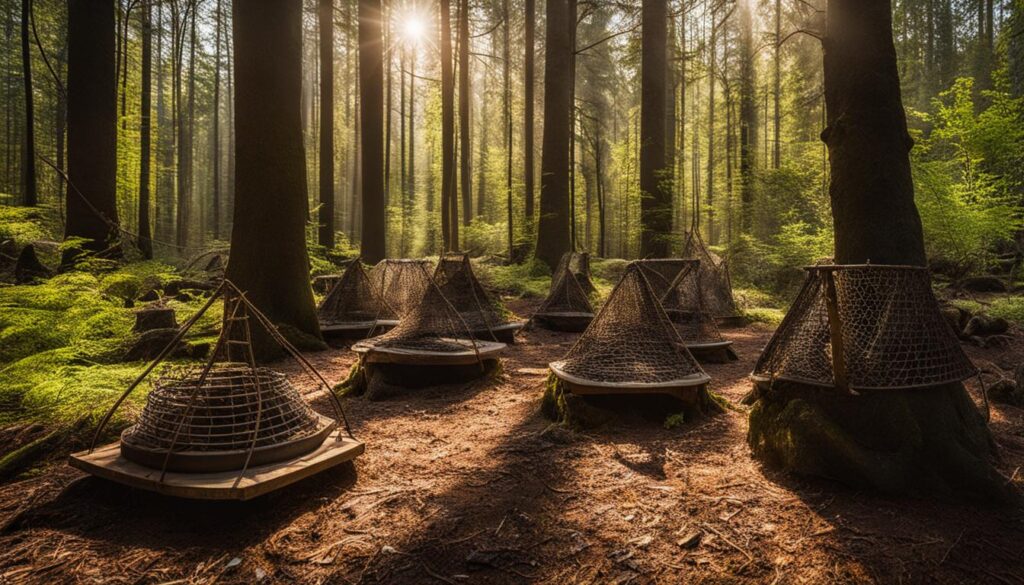
Remember, when using survival traps and snares, always prioritize the safety of both humans and animals involved. Practice responsible trapping techniques and comply with local hunting regulations. By honing your trapping skills, you can increase your chances of procuring food in a survival scenario and enhance your self-sufficiency in the wilderness.
Top Field Guides for Learning How to Trap
If you are not familiar with hunting or actively tracking an animal, it is recommended to pick up a good field guide. These guides provide valuable information on animal tracking, spotting game trails, and understanding where to set traps.
One highly recommended field guide is “The Tracker’s Field Guide: A Comprehensive Manual for Animal Tracking” by James C. Lowery. It is user-friendly and has great imagery. This guide covers a wide range of topics, including animal behavior, track identification, and trap placement.
Another excellent guide to consider is “Mammal Tracks & Sign: A Guide to North American Species” by Mark Elbroch. This comprehensive resource provides detailed track and trail data for 135 species, making it an invaluable tool for identifying and tracking animals in the wild.
These field guides are essential for anyone serious about learning trapping skills and mastering animal tracking. By studying these guides and applying the knowledge, you can significantly improve your chances of successfully trapping game for food.
Investing in field guides is an investment in your survival skills and self-sufficiency. Learning from experienced authors like James C. Lowery and Mark Elbroch will give you the confidence and knowledge needed to navigate the wilderness and successfully trap animals for food.
The Importance of Setting Traps in the Right Locations
One of the most crucial aspects of successful trapping is the strategic placement of traps. Understanding animal behaviors and tracking techniques is key to increasing your chances of capturing game and ensuring your survival. When setting traps, it is important to consider various factors that attract and direct animal movement. By identifying specific locations where animals gather or pass through, you can significantly improve your trapping success.
Here are some important considerations for trap placement:
- Game Trails: Look for well-worn paths that indicate high animal traffic. These trails serve as natural highways for animals, making them ideal trap locations.
- Watering Holes: Animals require water for survival, so setting traps near water sources such as streams, rivers, or ponds can yield positive results.
- Feeding Sites: Observe areas with abundant food sources, such as berry patches, fruit trees, or open meadows. These sites often attract a variety of animals and provide excellent trap placement opportunities.
- Animal Tracks and Droppings: Familiarize yourself with animal tracks and droppings in your area. These signs can help you identify preferred travel routes and feeding grounds to strategically place your traps.
- Chewed Vegetation: Animals leave behind telltale signs through their feeding habits. Chewed vegetation or stripped bark can indicate areas where animals have been foraging, making them potential trap locations.
- Nesting Sites and Den Holes: Identifying areas where animals nest or den provides insights into their natural habitats. These locations can be excellent spots for setting traps.
By actively building new traps, maintaining existing ones, and constantly scouting for new potential locations, you increase your chances of capturing food and enhancing your survival skills. Remember, the more traps you set in the right locations, the greater your chances of success.
“Understanding animal behaviors and tracking techniques is key to increasing your chances of capturing game and ensuring your survival.” – Anonymous
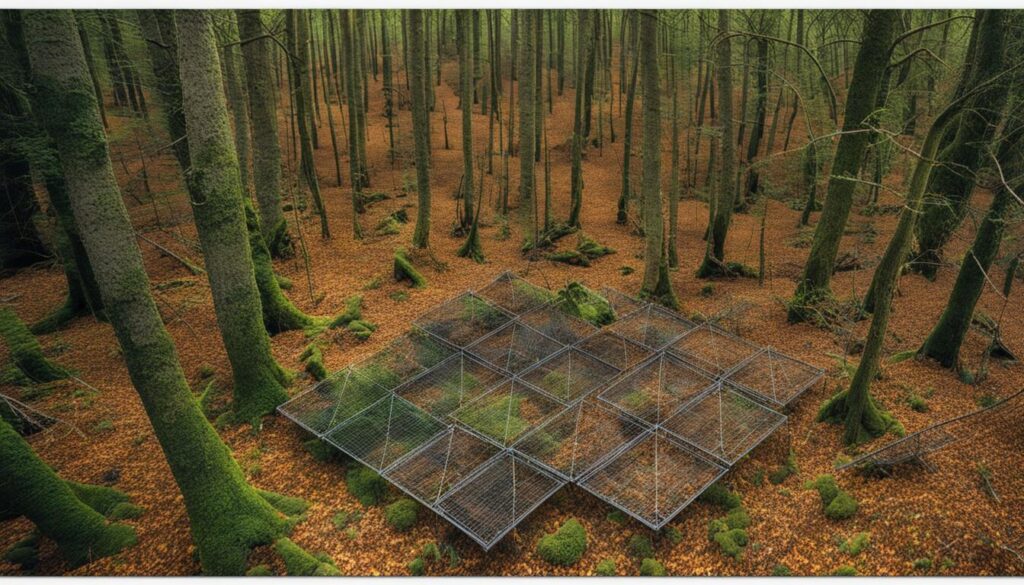
Recommended Resources for Learning Survival Skills
In addition to field guides, there are plenty of other resources available to help you learn essential survival skills. These resources provide comprehensive information on wilderness survival, self-sufficiency, and effective hunting techniques. By expanding your knowledge and improving your survival skills, you can better prepare for challenging situations and increase your chances of thriving in the wilderness.
Books for Wilderness Survival
- “How to Eat in the Woods” by Bradford Angier and Jon Young: This book offers valuable insights into finding food in the wilderness and provides practical tips on living off the land. It covers topics such as tracking, trapping, fishing, recognizing edible plants, and preparing food without utensils.
- “The Bushcraft Field Guide to Trapping, Gathering, and Cooking in the Wild” by Dave Canterbury: A comprehensive guide that teaches you essential skills for outdoor adventures. It provides step-by-step instructions on packing, trapping, and preparing food in the wild.
Online Resources for Survival Skills
There are several online platforms that offer valuable resources for learning survival skills, including:
- Survival.com: A comprehensive website that provides articles, guides, and videos on wilderness survival, self-sufficiency, and hunting techniques.
- Survival Life: An online community that offers a wealth of resources, including articles, videos, and gear recommendations, to help you develop survival skills.
- Practical Survivor: A website dedicated to providing practical information and tips on survival skills, including shelter building, fire starting, and self-defense.
Outdoor Survival Courses
Participating in outdoor survival courses is an excellent way to gain hands-on experience and learn from experts in the field. These courses often cover various survival skills, including wilderness navigation, shelter building, foraging, and hunting techniques. Some reputable organizations offering survival courses include:
- National Outdoor Leadership School (NOLS): NOLS offers a wide range of courses focused on wilderness survival, leadership, and outdoor skills. Their courses are designed to provide practical knowledge and hands-on experience in real-life scenarios.
- The Earth Skills Network: This organization offers immersive wilderness survival courses, focusing on primitive skills such as fire making, tool crafting, natural navigation, and wildlife tracking.
Exploring these resources, whether it’s through books, online platforms, or outdoor courses, will enhance your survival skills and increase your self-sufficiency in the wilderness.
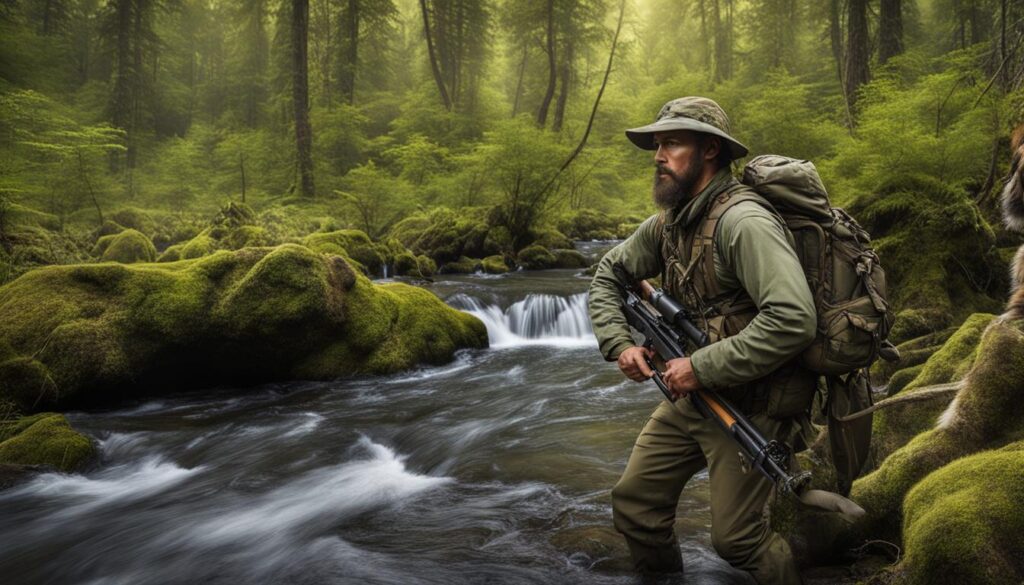
Safety Precautions and Legal Considerations
When it comes to survival traps, safety should always be a top priority. Building and using these traps without proper knowledge and caution can be extremely dangerous. It is crucial to understand the potential risks and take necessary precautions to ensure your own safety.
Some survival traps can be lethal, posing significant dangers if mishandled. It is recommended to seek guidance from experienced individuals or take professional training before attempting to use such traps on your own.
In addition to safety concerns, it’s important to be aware of the legal restrictions and hunting regulations in your area. Using traps in certain locations and situations may be prohibited by law. Always check local hunting regulations and obtain any necessary permits or licenses before setting up traps.
Survival traps should only be utilized in true survival situations, where they are needed for sustenance and survival. Using traps recreationally or in non-emergency situations can lead to environmental damage and wildlife disturbance.
Safety Tips for Building and Using Survival Traps:
- Learn from experienced individuals or take professional training before attempting to build and use survival traps.
- Always exercise caution and follow proper safety guidelines when handling and setting up traps.
- Ensure that traps are well-constructed and sturdy to prevent accidental release or premature activation.
- Regularly inspect and maintain traps to ensure they are in good working condition.
- Keep traps away from areas where children or unsuspecting individuals could accidentally encounter them.
- Dispose of any unused or broken traps responsibly to prevent harm to wildlife and the environment.
In a survival situation, it is crucial to have the necessary skills and knowledge to provide for your own sustenance. However, it is equally important to prioritize safety and adhere to legal restrictions. Always approach survival traps with caution and respect for the environment and wildlife.
| Important Safety Precautions: | Legal Considerations: |
|---|---|
| Seek guidance from experienced individuals or take professional training before building and using survival traps. | Familiarize yourself with local hunting regulations and obtain any necessary permits or licenses. |
| Handle traps with caution and follow proper safety guidelines to prevent accidents and injuries. | Ensure that the use of traps is limited to true survival situations and not for recreational purposes. |
| Regularly inspect and maintain traps to ensure they are in good working condition. | Dispose of unused or broken traps responsibly to prevent harm to wildlife and the environment. |
The Benefits of Hunting and Trapping for Food
In a survival situation, hunting and trapping for food offers numerous benefits that contribute to self-sufficiency, sustainable living, and wilderness survival. By mastering these skills, you can rely on the land to procure sustenance, creating a renewable and sustainable source of food. Furthermore, the acquisition of these skills enhances your wilderness survival abilities and fosters overall self-reliance.
Understanding animal behaviors, tracking techniques, and trap placement significantly improves your chances of successfully procuring food in a survival scenario. By learning how to capitalize on these aspects, you can navigate the wild more effectively, increasing your ability to locate and capture game.
“Hunting and trapping for food allows me to become self-sufficient and survive off the land. It’s a skill that supports sustainable living and empowers me to rely on natural resources for sustenance.”
By honing your hunting and trapping skills, you can tap into the primal instinct of self-sufficiency, adapting to the challenges and demands of the wilderness. These skills enable you to sustainably procure food while minimizing your impact on the environment.
Enhanced Self-Sufficiency
Hunting and trapping for food promotes self-sufficiency by reducing reliance on modern conveniences and transforming you into a self-reliant individual. Instead of depending on supermarkets or industrial food production, you gain the ability to provide for yourself through skills rooted in ancestral knowledge.
Sustainable Living
Engaging in hunting and trapping for food aligns with sustainability principles, as it fosters a more harmonious relationship with nature. By procuring food from the wild responsibly and within legal boundaries, you ensure a renewable source of sustenance while preserving the delicate balance of ecosystems.
Wilderness Survival
Learning hunting and trapping skills equips you with essential knowledge and abilities for wilderness survival. By understanding animal behaviors, tracking their movements, and strategically placing traps, you greatly increase your chances of securing food in a survival scenario.
Overall, hunting and trapping for food are valuable tools for self-sufficiency, food procurement, and sustainable living in the wilderness. Embracing these skills not only fosters a deeper connection with the natural world but also strengthens your ability to thrive in challenging environments.
Conclusion
Mastering the art of hunting and trapping for food is crucial for wilderness survival and achieving self-sufficiency. By honing your skills in building effective traps, understanding animal behaviors, and identifying optimal trap locations, you significantly increase your chances of securing a source of nourishment. It is important, however, to approach these skills with a sense of responsibility and reverence for the animals and the environment.
Always prioritize safety when setting up traps and handling wildlife. Ensure you are familiar with and adhere to the legal regulations governing hunting and trapping in your area. Being knowledgeable and respectful not only protects you but also ensures the sustainability of these practices for generations to come.
With the right knowledge and practice, hunting and trapping become powerful tools for achieving self-sufficiency and thriving in the wilderness. Embrace these skills as a means of connecting with nature, relying on the land, and cultivating a deeper understanding of the natural world. By embracing this mindset and respecting the delicate balance of the ecosystem, you can truly thrive in the wild and achieve long-term wilderness survival.
FAQ
Why is hunting and trapping for food important in a survival situation?
Hunting and trapping for food is essential for survival in a long-term survival situation. It provides a source of high-fat and high-protein foods, ensuring you get enough calories to sustain yourself.
What are the most common types of survival traps?
The most common types of survival traps are snares and deadfalls. Snares are small nooses that tighten around an animal’s neck, while deadfalls are designed to crush the animal once the trigger is released.
How can I improve my chances of catching something with traps?
Baiting your traps greatly improves your chances of catching something. Placing traps in known animal trails or outside den holes and setting them in the right locations, such as game trails, watering holes, and feeding sites, can also increase your chances of success.
Are there any recommended field guides for learning animal tracking and trapping?
Yes, “The Tracker’s Field Guide: A Comprehensive Manual for Animal Tracking” by James C. Lowery and “Mammal Tracks & Sign: A Guide to North American Species” by Mark Elbroch are highly recommended field guides for learning about animal tracking and trapping.
How can I identify good trap locations in the wilderness?
Look for known game trails, watering holes, feeding sites, animal tracks and droppings, chewed vegetation, nesting sites, and den holes. These locations are often frequented by animals and increase your chances of capturing food.
Are there resources available to help me learn survival skills?
Yes, books like “How to Eat in the Woods” by Bradford Angier and Jon Young and “The Bushcraft Field Guide to Trapping, Gathering, and Cooking in the Wild” by Dave Canterbury provide comprehensive information on survival skills, including trapping for food.
What precautions should I take when using survival traps?
Building and using survival traps can be dangerous if you don’t know what you’re doing. Some traps can be lethal. It is important to approach these skills with caution and seek guidance from experienced individuals. Additionally, be aware of local hunting regulations and restrictions on the use of traps in your area.
What are the benefits of hunting and trapping for food?
Hunting and trapping for food allows you to become self-sufficient and rely on the land for sustenance. It provides a renewable and sustainable source of food, enhances your wilderness survival abilities, and increases overall self-reliance.
